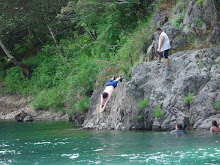"Are you worried someone could 'steal' your ideas and profit?"
The short answer is no.
The goal of this blog has been to share, with EVERYONE, the experience I had taking an idea from concept to prototype. For this project, I have taken the stance that what I have learned should be open to anyone else looking to have a similar experience. I would feel nothing short of accomplishment if someday I found a shooting timer that has implemented some facet of my project.
Thus far, I have posted several items discussing, in detail, what my goals were with Project Smoke & Hope. Included in these items are detailed schematics, a demo user interface, and information pertaining to the necessary parts required to duplicate what I have done. In future posts I will provide source code for both the hardware and software aspects.
There are a few reasons why I feel sharing this information is important:
I'd like to leave you with a final thought:
The goal of this blog has been to share, with EVERYONE, the experience I had taking an idea from concept to prototype. For this project, I have taken the stance that what I have learned should be open to anyone else looking to have a similar experience. I would feel nothing short of accomplishment if someday I found a shooting timer that has implemented some facet of my project.
Thus far, I have posted several items discussing, in detail, what my goals were with Project Smoke & Hope. Included in these items are detailed schematics, a demo user interface, and information pertaining to the necessary parts required to duplicate what I have done. In future posts I will provide source code for both the hardware and software aspects.
There are a few reasons why I feel sharing this information is important:
- Some of the problems I have faced and solved are ones that have already been solved by companies producing these timers. This information should be open to everyone so that someone might improve what already exists.
- The concepts I have attempted to expand upon are still in a rough stage, and need much work to become a fully functional consumer product.
- The prototype I have developed is only a single piece in a much larger implementation that I have in mind for future ventures. It is this concept that I would plan to expand and develop as a marketable product.
I'd like to leave you with a final thought:
"The best way we truly learn is by sharing what we know with those around us."
• • •
• • •












